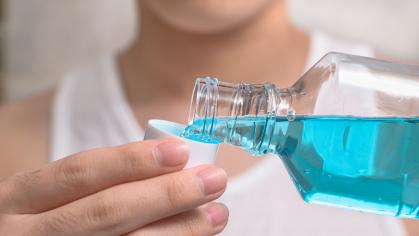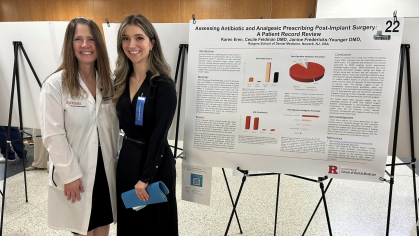Education Enhanced by Research
Athena Fu ’23 has always been interested in research. She enjoyed studying corals as a biological sciences major. When she completed her undergraduate degree, she thought her research career ended. But it has instead grown stronger at RSDM, where she’s a fourth-year DMD candidate.
“Research has really enriched my dental school experience and was definitely something I didn't think I would get to experience,” she said.
She also didn’t foresee it would take her places.
 Athena Fu with her poster at the Hinman Student Research Symposium.
Athena Fu with her poster at the Hinman Student Research Symposium.
Fu won first place among predoctoral students at the 2022 Balbo Day. This was “a really big honor,” she said. A few months ago, she presented her poster at the Hinman Student Research Symposium, a national conference organized by the University of Tennessee Health Science Center, College of Dentistry, for dental students and graduate trainees from American and Canadian schools to present their research.
“I'm very lucky to have been able to travel and represent our school in such a way,” she said. “It was honestly very interesting because I don't think I realized the wide range of research that's being done.”
Fu started doing research at RSDM two summers ago. She heard about the school’s summer research program and put her name down. Eyeing orthodontics, she chose a project related to it and began working with Wei Huang, assistant professor of orthodontics. Their project examined how well the digital scans used to make clear aligners match patients’ actual teeth.
“Athena is a very enthusiastic and diligent student researcher,” said Huang. “I really enjoyed working with her.” Fu worked on 3D data analysis, superimposing printed models with scans of the patient’s mouth to assess how they fit. “She was able to acquire a large amount of data first and then extract meaningful results,” noted Huang. “Her work has contributed significantly and added an important layer of confirmation to our finding that the maxillary lateral incisors' tooth size changes in 3D printed dental models may be the underlying mechanisms by which these teeth often track poorly—don't hold on to the trays—during aligner therapy.”
This kind of real-life impact of research is what attracted Fu to pursue it.
“I love this project provides a possible understanding of a problem that's faced with aligner therapy,” Fu explained. “It's important to do and know research because it tells why we incorporate certain types of treatments and the evidence behind techniques we’re taught in school. Doing research gave me an insider’s look into that process. … It definitely enriched how I approach dentistry.”
She continues working with Huang, exploring other effects of 3D printing on clear aligner therapy. Next year, she’s starting RSDM’s orthodontics postgraduate program.
“I will be at RSDM for another 3 years!” she said with excitement. For those coming after her, she said, “I hope more students partake in research just because it's another facet of dentistry that they don't necessarily get to experience if they don’t take the initiative to go out and take that opportunity."



